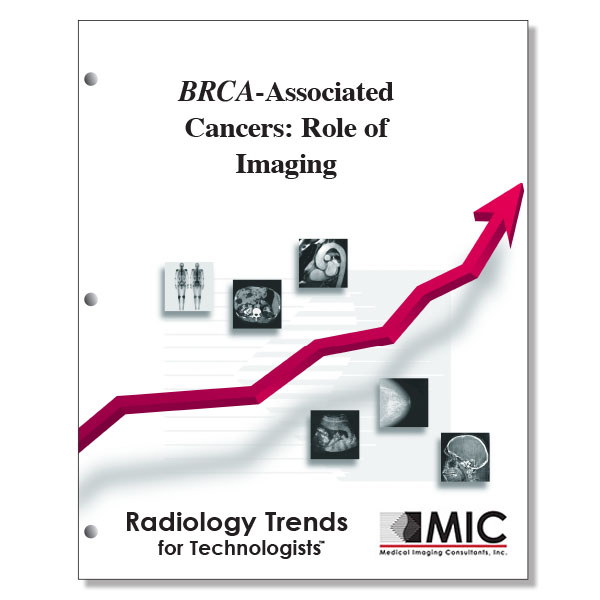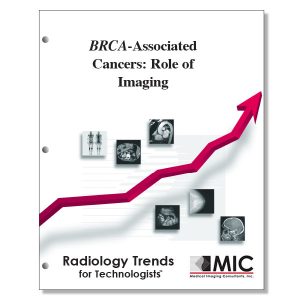

BRCA-Associated Cancers: Role of Imaging
The pathophysiologic and imaging features of tumors associated with the BRCA gene mutation are presented.
Course ID: Q00540 Category: Radiology Trends for Technologists Modalities: CT, Mammography, MRI, Radiation Therapy, Sonography3.0 |
Satisfaction Guarantee |
$34.00
- Targeted CE
- Outline
- Objectives
Targeted CE per ARRT’s Discipline, Category, and Subcategory classification for enrollments starting after January 30, 2024:
[Note: Discipline-specific Targeted CE credits may be less than the total Category A credits approved for this course.]
Breast Sonography: 1.50
Patient Care: 1.00
Patient Interactions and Management: 1.00
Procedures: 0.50
Pathology: 0.50
Computed Tomography: 1.00
Procedures: 1.00
Abdomen and Pelvis: 1.00
Mammography: 1.75
Patient Care: 0.50
Patient Interactions and Management: 0.50
Procedures: 1.25
Anatomy, Physiology, and Pathology: 0.75
Mammographic Positioning, Special Needs, and Imaging Procedures: 0.50
Magnetic Resonance Imaging: 1.50
Procedures: 1.50
Body: 1.50
Nuclear Medicine Technology: 0.50
Procedures: 0.50
Endocrine and Oncology Procedures: 0.50
Registered Radiologist Assistant: 3.00
Procedures: 3.00
Abdominal Section: 1.25
Thoracic Section: 1.75
Sonography: 1.00
Procedures: 1.00
Abdomen: 0.25
Gynecology: 0.25
Superficial Structures and Other Sonographic Procedures: 0.50
Radiation Therapy: 3.00
Patient Care: 1.50
Patient and Medical Record Management: 1.50
Procedures: 1.50
Treatment Sites and Tumors: 1.50
Outline
- Introduction
- Breast Cancer
- Pathologic Features
- Role of Imaging
- Mammography
- Ultrasonography
- MR Imaging
- Cancer Staging
- Screening Guidelines
- Male Breast Cancer
- Management
- Extrauterine Pelvic Serous Carcinomas
- Ovarian Cancer
- PFTC and PPSC
- Pancreatic Cancer
- Prostate Cancer
- Colorectal Cancer
- Conclusion
Objectives
Upon completion of this course, students will:
- name the chromosomes where BRCA1 and BRCA2 suppressor genes are located
- recall the number of BRCA gene mutations
- list the risk factors associated with the BRCA genome
- state the pattern of transmission for the BRCA gene mutation
- know the chance that first-degree relatives of BRCA mutation carriers also may be carriers of the mutated gene
- state how imaging contributes to helping patients with BRCA mutations
- list factors that help provide a definitive diagnosis for BRCA mutations
- recall the number of women estimated to be diagnosed with breast cancer in 2016
- express the estimated percentage of female BRCA2 mutation carriers that will develop breast cancer by age 70
- list the phenotypes of breast cancer that help identify individuals that carry germ line mutations of the BRCA genes
- state the median age of breast cancer diagnosis for BRCA carriers
- recall the percentage invasive ductal carcinomas in BRCA mutations carriers
- state the type of breast cancer that is almost never identified in BRCA1 mutation carriers
- define the “triple negative”
- recall the sensitivity of mammography for the detection of breast cancer in BRCA mutation carriers
- describe the growth rate and lead time for BRCA-associated breast cancers
- determine the most accurate type of mammography for young women with dense breast tissue
- list the mammographic findings that best detect a malignant lesion
- state the most commonly described mammographic feature of BRCA-associated breast cancers
- recall the study reporting that breast lesions in BRCA mutation carriers were more often round with sharp well-defined margins as compared with malignant lesions in a matched sporadic control group
- describe the shape of medullary breast cancers in BRCA1 mutation carriers
- identify the study that concluded that ALL mammographically detected lesions should be further evaluated with ultrasound and biopsy
- state the ultrasound appearance of BRCA-associated breast cancers
- state the imaging modality used for breast cancer screening for high risk women who have contraindications to magnetic resonance imaging
- express the sensitivity and specificity of breast magnetic resonance imaging
- identify the screening trial that compared annual MR imaging with annual mammography and the sensitivity of each
- document the combined imaging modalities currently recommended for screening BRCA mutation carriers
- state the fraction of BRCA mutation carriers with stage IV cancer that will develop brain metastases
- recall what type of metastases is rare in BRCA2 mutation carriers
- state the age at which breast awareness measures should begin for women with BRCA mutations
- express the risk reduction for breast cancer experienced by BRCA mutation carriers who undergo prophylactic mastectomy
- state the median age for BRCA-associated male breast cancer diagnosis
- state the age that men with BRCA mutations should begin breast self-examination
- know the percentage of women with a BRCA2 mutation that may develop ovarian cancer by age 70
- list the conditions commonly associated with high grade serous carcinomas
- list the similarities between PFTC, PPSC, and serous ovarian carcinoma
- distinguish between relative risk for PDAC in BRCA-mutation carriers and those in the general population
- recall the approved version of the Prostate Imaging Reporting and Data Systems guidelines
- state the most common histologic subtype of colon cancer in BRCA1 mutation carriers
- express the imaging examination of choice for evaluating patients with colon adenocarcinoma
